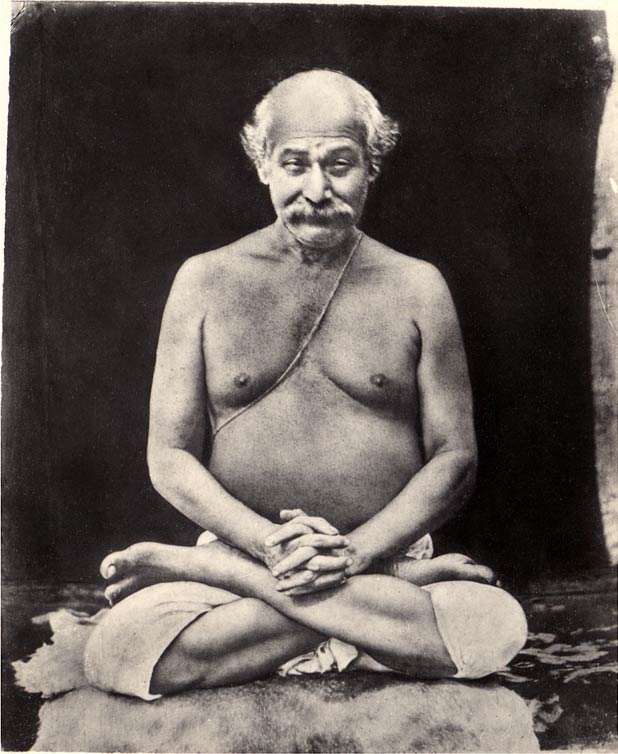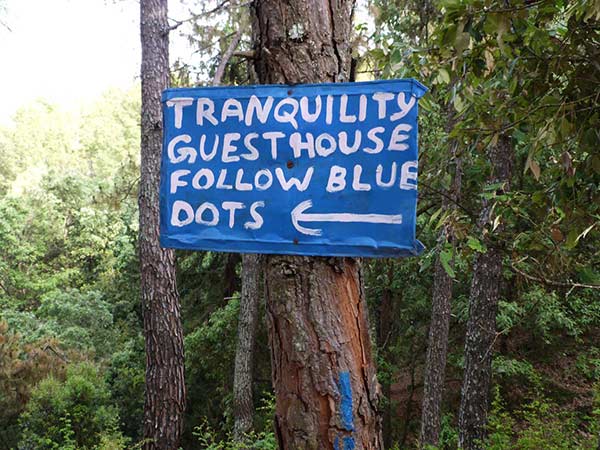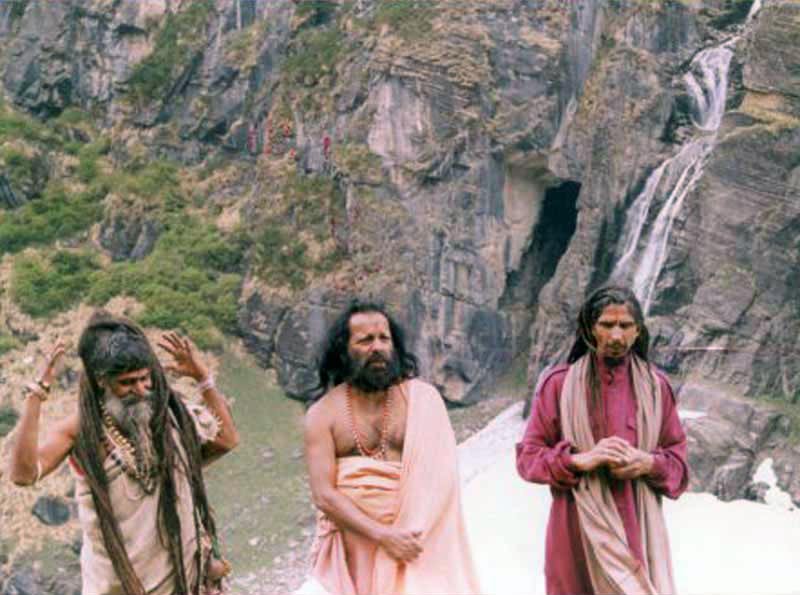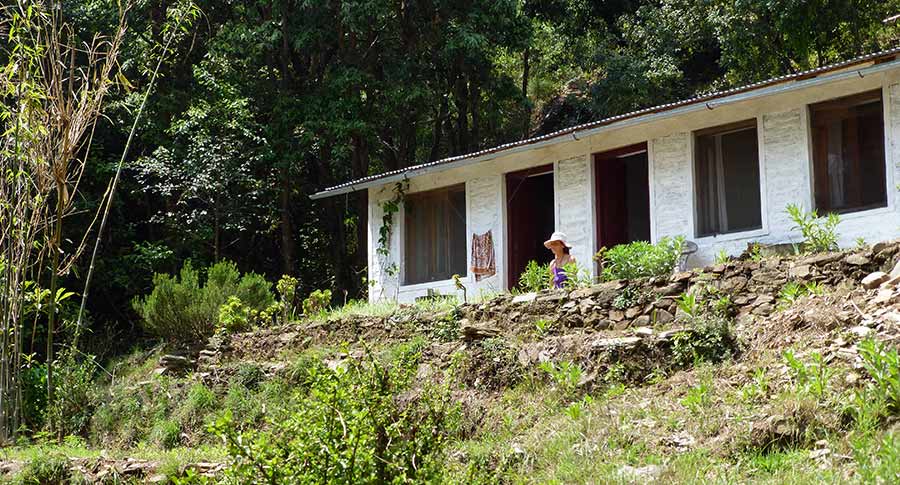
View from Sacred Mountain Retreat (photo by Virochana)
For a sincere practitioner of kriya, the mere mention of the word is one of sacredness, so strong is the meditative state and freedom associated with it.
Yet for all of its allure, there has been a trend in the modern world to present it as just techniques along with priestly claims of ‘ownership’ that
strains credibility and in conflict with the freedom of our natural state beyond labels.
In this article, and as a practitioner since the 1970’s of kriya from several lineages, I hope to restore a sense of what the essence of kriya is about. I
will briefly mention several different lineages of these arts, and perhaps, inspire you dear reader to investigate for yourself through practice, and for
seasoned participants to ring the bell of joy inspiring your continued sadhana, in which we get there by being there.
Kriya means to take action and as a practice starts as an active synthesis of breath, visualization, mental focus, repetition, discipline, internal
alchemy, a good nature, and posture to internalize our awareness. In contrast to a passive approach, which also has its place, kriya charges and directs
the current of your mind and breath, which keeps you engaged as you ride it into a deeper centering of presence. Of course, it does require willingness to
surrender outer thoughts and limited views in the process.
In context, I assume that it is understood that kriya is one aspect of a whole approach to spirituality, which together is more effective and fulfilling.

Lahiri Mahasaya
KRIYA of LAHIRI MAHASAYA
Lahiri Mahasaya was an adept in the late 1800’s, later made famous far beyond the area he lived in through Yogananda’s Autobiography of a Yogi. Known for
his cheerful disposition and profound meditative abilities, he was and is a direct disciple of a Himalayan Immortal, and as outlined in Yogananda’s book,
helped to bring Kriya yoga into the householder tradition.
During his initial month with his Guru in Dunagiri, a place in the foothills of the Himalayas, he received over a hundred techniques and wrote them down in
a notebook, but none of these compared to the transcendent states awakened in him. In his love and quest to make this approach accessible to his brethren,
he consolidated and formulated them into a simpler set suitable for sincere householders who have fewer hours of the day for practice along with a
different dynamic. In time he lost the notebook, and then forgot some of the practices. Years later when he retired from work as an accountant, he entered
into full time formal sadhana and no longer even needed to sleep. He initiated Hindus, Muslims, Christians, Men and Women, and people of no particular
faith, day and night – and always emphasized self-realization through sincere application.
Lahiri taught the importance of the after effect, along with stopping a kriya when certain sublime states are reached, and quietly remaining in it. In the
potency of this breathless alive stillness and its divine alchemy, further advancement and familiarity occurs and is carried forth in conjunction with the
integrative lifestyle of a householder. This was his secret to brining the full enlightenment of kriya within grasp of householders, along of course with
his tireless help.
To understand this in context, kriya is sometimes done non-stop for 8, 10, 12 hours, or even multiple days at a time by advanced practitioners, so as to
build an extreme potency of particular pranas and the fluency of siddhas, all within a different perspective than householders and thus a different
culture. This is often in conjunction with service, such as Lahiri himself did in his later years of practice.
The Kriyas associated with Lahiri are organized into stages simply called first, second, etc. First Kriya is a set of preliminary techniques, powerful in
their own right, consisting of a pranayama with visualization up and down the spine and its sides, Maha Mudra, Yoni Mudra (listening and internalizing
inside your head), and Nabhi (navel) kriya. These give the practitioner a balanced ability to focus their mind, clear obstructions, and discover the spirit
of the practice. For many it is as far as they want to go, and that is fine and wonderful as is. The body becomes the sacred temple which they formally
visit each day.
As first kriya matures, the practitioner begins to settle within their central channel, which automatically brings an internalization and a completely
different view of life.
The remaining kriyas are extensions that build on this foundation, and are useless without it. They start properly with the ability to hear the sounds of
the pranic current in the body, also called Om Kar, emanating from a set of chakras or places of focus and nectar. They also bring in Kechari mudra which
the practitioner has already been developing mid-way into first kriya. In kechari mudra the tongue connected behind the uvula stabilizes the power of a
deeper current and enables the further blissful absorption of the senses, such as touch, into a primal reality. Classical elemental awareness is
cultivated as well and its alchemy.
Second Kriya brings the nectar down and opens the heart. It further internalizes the breath so it is no longer felt as deriving its force from the
physical, and thus develops your mental force conjoined with prana. Third Kriya further stabilizes this in the heart. Fourth Kriya brings much longer
sadhana into effect and each chakra one by one is brought up to the center of the head or further, and then back down, so that all of the chakras are felt
like reflections emanating out of the place you bring it to. Fifth Kriya is a very subtle breath that rings the body like a bell and can ascend it. The
physical body itself is no longer different than consciousness.
One quality of this lineage of Kriya is that instead of starting from the base chakra, it emphasizes the descent, and from there everything is clear and
the rising is relatively effortless. That does not mean the base chakra is ignored or that the rising of kundalini is not experienced. This continues
through several cycles, and the origin is raised in more advanced forms of kriya. Transmission becomes not about outer technique, but rather about the
nuances and perspective of this evolvement.
OTHER KRIYA APPROACHES
There are many types of kriya. Yogi Bhajan gave many excellent practices, such as the Kriya of Five Sounds (Sa-Ta-Na-Ma) and Long Ek Ong Kar… with 3 ½
breaths. These are widely available in the public domain. For a person with only time for a shorter practice, then the Kriya of Sa-Ta-Na-Ma with the ‘L”
shaped descent through the top of the head and out of the third eye will bring more benefit.
Another effective approach is the set of 20 kriyas taught by the Bihar School of Yoga and presented in the book Kundalini Kriya Tantra by Satyananda. Once
you are fluent in the techniques, I personally have found that greater benefit is obtained by extending the times recommended in their book, which to me
seem rushed.
There are many Taoist and Buddhist Kriyas as well. Robert Peng has a book called ‘The Master Key” in which he presents in an easy to follow format a few
Nei Kung techniques he calls the 4 golden wheels which are very transformative.
While it is good to take a particular practice and follow it through; I believe it is of tremendous value, and somewhat natural, to learn from different
practice approaches. This way you can gain perspective, a more integrated view, become less fanatical in your enthusiasm, and start to understand the
essence, the how, why, reason, fruit, of various practices. Of course all of this assumes a drive on your spiritual path to awaken internal self-definition
and knowingness in contrast to just being scattered.

North Crestone 2010 (photo by Virochana)
POSITIVITY and PURITY
Kriya emphasizes a positivity of outlook and honoring of energetic purity for several reasons. While amplifying our life-force and surfing it into our core,
it is important not to poison ourselves with increased negativity. This is one of the reasons, that Lahiri Mahasaya, who some consider the father of modern
kriya, emphasizes to beginning students that they should always use a positively held mantra and definition in their internal visualizations rather than
let an un-stabilized mind wander in sub-conscious thoughts, which he considered dangerous when combined with breath and internalization.
Furthermore, in replacing negativity with positivity, we start to see the nature of mind and samsara itself, which is an important part of a spiritual
practice that no one can do for us. In the creation of a strong upward direction through pranayama, a refinement of vitality and sensitivity is created
which energetically and sometimes violently contradicts what was previously acceptable. But in removing old ways, it gives the enjoyment of new ones,
seductively rising us into rarified states.
However, perhaps the most important reason is beyond moral precepts of what positivity and purity is or not, and this is first recognizing and then
shifting the weight of our awareness into the nucleus of our causal presence, like self-shining stars within, whose very nature has a positive and
expanding effect. Focusing within this causal aspect of ourselves is an important part of more advanced Kriya, and a first step of awakening.
CONSISTENCY and APPROACH
While there are many approaches to Kriya, one thing in common is the requirement of consistency which then develops a ‘Sadhana’ or daily spiritual
practice. As kriya builds, it can be very enjoyable, but if it's just another mode of entertainment, its days are numbered. One starts with where one is at,
without judgement, and gradually advances step by step, while valuing a tenacity to keep picking oneself up when tripping.
More and longer is a mantra of advanced yogis, but not suitable in the beginning. It is better to set very reasonable bounds for a length and type of
practice that can be maintained, and then to focus on actually maintaining and refining it. As the bliss of Kriya begins to be felt, often enhanced in the
company and transmission of like-minded people - this in itself spurs further practice and propels us.
It is a principal of Kriya not to become ambitious, although in our excitement, sometimes this might be hard, and enthusiasm is always a wonderful quality.
But in the practice itself - let go of goals so that you can be fully present with each breath, each internal or external movement. It is this timeless
presence that builds and becomes the first essence of kriya.
It is not everyone’s desire to take such a practice to its ends. For many, having familiarity with a tool they can use within the challenges of life, and
the resultant direct experience is enough, a jewel within. For those who feel the calling to go further within the Kriya approach, the practices become a
lifeline of necessity, amidst the deeper cleansing, countless small deaths, service, and alignment. In this refinement, moving away too long from this
silent, awake, and unspeakable clarity is like a death sentence. For such a person, no one needs to explain this, it just is the situation - so advanced
kriya is not something that can ever be mass marketed, rather it awakens as one is ripe for it.
Finally, emotional integration and development is its own sphere of importance, and a vital aspect of our maturity and wholeness – and plays a crucial
alchemical part in the bigger picture. Unfortunately, there tends to be a tendency to bypass this by some traditional kriya practitioners.
There are subtleties and alchemies that can only be understood through experience and inner transmission, that form part of this lineage, which are beyond
and yet integrated into the practices. These come in their own time, through a combination of play and being present with the practice. Something that Shiv
Baba emphasized a number of times to me is that when I needed to stop and focus on a particular aspect, not to feel that I am breaking the kriya. For
example, if working in an area of the spine and staying with it for an hour or two.

Near Keshari Devi above Almora (photo by Virochana)
INITIATION and TRANSMISSION
Initiation is an introduction to the flavor and possibility of a practice or approach, a set of instructions, and the presentation of what is possible.
Transmission is the direct non-verbal sharing of what it feels like, so that we can then take that feeling and cultivate it for ourselves. This occurs at a
level of unity in the oneness.
Transmission can also unfold into the future through the field of an adept touching a living causal point within a practitioner, like a seed – and when the
space is maintained properly, eventually flowers into full awareness.
In the first years of formal spiritual practices, the interplay of circumstances, lifestyle adjustments, past life streams, cognitive ability, physical
nature, acceptance of self-responsibility, etc., etc., really means that initiation is a work in progress, more of an art. By gaining experience, what was
previously abstract becomes workable and we can better apply subtleties, such as resting in our central channel, as well as the ability to hear and
comprehend what is being said.
There has been a lot of press that spiritual practices have no potency without formal initiation by a master, and while there is some truth to this, the
way it is sometimes presented is almost laughable. I have seen people line up to a literally drunken teacher sitting on a high pile of mediation cushions
giving every initiation in the book, along with a tipsy blessing movement of the hand, and the people counting their good luck, as if it meant anything.
It is a mistake to think that a kriya adept can do the work for you, burning all your karma in the process. So much can be secretly done, but no real
master will take that achievement from you, as this is your mastery at stake, your familiarity, your essence and expression, and your dance in it all.
Closer to the truth is that we are self-initiating. Through our sincerity, hard work, timing, and readiness, we align with and open into the space of
transmission so we understand what a practice is ultimately all about. This can occur in collaboration with direct instruction in the physical, in a dream,
a glance, even your own self. You cannot buy it in a workshop.
It can take years, lifetimes, days, ... but without it there is no seed to grow, no depth to revolve around, beyond all the talk and attachments,
and the rising and falling of breath and yogic application.

River Ice in North Crestone (photo by Virochana)
A LIFELINE TO CLARITY
Kriya is a lifeline to clarity. It takes us as we are, and strips us of what we are not. Through a sincere application, all the escapades of our day are
dissolved into the simple current of attention returning us to our happy radiance that is our very nature. Again and again.
This body becomes a temple and in it we discover our self. It is the doorway to tantra, and the ability to apply oneself beyond the thinking mind and
within the innate wisdom of pure awareness.
It is a science of applying oneself, of learning how to focus, the art of stillness, movement, relaxation, and vitality combined. It is practical and
simple once the basics are mastered.
The secret to kriya, is that the outer kriya reveals the inner kriya. Outer kriyas can be described in a few pages, but the inner kriya, as it unfolds,
even with volumes is beyond capture but seen by those who understand.
These days there is a pride of arguing over the validity and accuracy of various techniques, as if consciousness is bound to a technique.
A kriya adept when transmitting the technique, can see how a person's shakti resides in the body, where it is at, and what it is saying, and adjusts what
is emphasized and given accordingly. No fancy hard to pronounce words are needed, rather a relationship is formed that is natural and allows the insight to
correctly help with guidance.
A kriya practitioner learns to stand on their own two feet, distilling their expressive image with an unfolding to understand directly the inner nature and
their place in that. Each adept honors that process in each other, the lessons giving wisdom, and the teaching process.
As it evolves, kriya expands in scope. The atoms of the air dance in divine sound and nature itself participates. Kriya can become like a whisper and a
prayer of love spreading through the universe. The form can change, but the essence remains.
STILLNESS
As kriya internalizes the breath, it is naturally slowed down, for example to 90 seconds per breath over an hour or two, without any holding and smooth.
As this happens the prana remains within the body, and prior to that the breath gives us energy for the transition. So it is perceived like a river
nourishing from within of our own essence. Eventually the outer breath disappears all together in this beauty.
Mantra seals the flow of the mind into a single current bringing stillness and vitality. From there, combined with a spacious quality in our central flow
we learn to hear the internal sounds of our subtle pranas, which carries both satisfying beauty and also a subtle force. The sounds can replace the mantra
at each point of our focus, and they can charge the internal sounds not unlike hearing voices in the flowing of a river. This pinpoints the causal center
of our chakras within the relationship of our body.
There is a misconception that the higher kriyas are techniques, and only if we can learn them, we have the keys to the kingdom, where actually they are a
shifting of how you perceive and where the balance of your conscious activity is held from; which is from beyond the persona but connected to it.
The dynamic movement of prana transforms into a stillness of prana, that contains tremendous vitality and fullness. It is the presence of this that is this
essence of kriya. One of the ways this is introduced, is that while moving the breath and attention up and down through the chakras, a steady relaxed focus
is simultaneously held in the forehead or another center.

Pilot Baba and Gorak Baba in Himalayas
LINEAGE
One side of kriya is the technique and self-absorbed practice of it. The other is lineage. This is personal, and the importance of it varies from person to
person, and the particular kriya practices being done.
For example, in the formal practices associated with Lahiri Mahasaya, the aura of the practices is the presence of accomplished adepts who inwardly help various sincere practitioners. Doing the practices is like visiting a certain place to get the vibe or speaking a particular language that opens you
to this current. It is extremely valuable and beyond the techniques themselves, and for some people it is the primary attraction.
Yet there are many who do not have that particular connection, and practicing the techniques still brings benefit and potentially helps an opening into other families of light that they associate with, and perhaps in the process meet beings who are new to them as well. It is a grace.
For myself, the Kriya of Lahiri has always been deeply associated with Shiv Baba, more popularly known as Mahavatar. With thousands of communions,
practicalities, multiple contacts into the physical, instructions, and love, it is a relationship bridging the span of consciousness. I have also had eyes
open Darshan of Lahiri more clear than normal sight, and one thing I can say with great clarity is that the essence of this kriya lineage is much more than
the meditative techniques. But it is an entry which evolves us, potentially each of us, to this place.
Lahiri did not like hype and organizations, and asked for no organization to be formed around him, insisting that the activating essence of the
practitioners themselves will draw forth those who are ready. This was also in harmony with honoring the many different paths of people in society (in
contrast to fanaticism), as well as maintaining the purity and connection.

Retreat Cabin in Keshari Devi above Almora (photo by Virochana)
POSSIBLITIES
In finishing, I believe it is good to introduce what is possible in this dance of joy.
Kriya, as it matures, opens us directly to non-dual awareness. In short, everything is consciousness, but more than the intellectual or occasional
realization of this, it becomes a 24/7 backdrop not unlike space itself and your existence in it.
At some point, this becomes a totality, and for lack of better words on the way back, while already touched upon, instantaneously a very subtle and eternal
expression awakens and from then on is always in some degree of awareness. It is this subtle expression which is enlightened, a kind of body, and yet it
could be a hundred bodies; the word body in this case is the field of very subtle individuality.
In the continuum with your physical being a much different view develops. For example, it seems natural, even when driving a car, to have your awareness
subtly spread out for a hundred miles, and yet still in your body and talking while being alert to the road. It is beyond what can be claimed and owned,
but is very real. So with the eternal anchor of non-dual awareness, and your enlightened and unlimited soul expression, a tantra develops.
So while transcended, the Kriya is still valuable and has a part to play in this descent. It is why incomparable masters, will still do an actual kriya
practice, even when they no longer have any need for it. The Kriya is pure, transcendent, and yet breathes the fabric of creation and is in service to creation
– in Love.